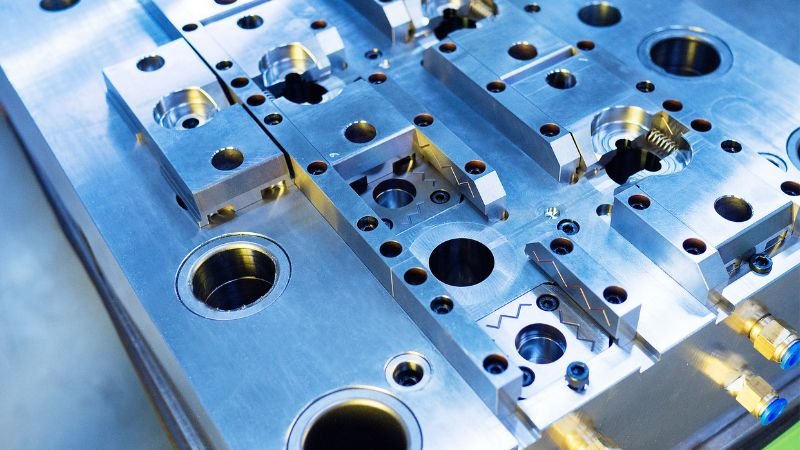Nthuts'i ñut'i
Definition of Large Injection Molding
Large injection molding refers to the fabrication process for producing sizeable plastic components, typically those that exceed 24 inches in any one dimension. It involves injecting molten plastic into a sizable mold cavity and is an indispensable method for crafting substantial parts used in various sectors.
Brief History and Evolution
Beginning with the development of the first injection molding machine in the 1870s, the technology has significantly evolved. In the mid-20th century, the demand for larger plastic items for industrial use spurred the growth of large injection molding. Advancements in computer-aided design (CAD), computer-aided manufacturing (CAM), and the introduction of high-tonnage injection molding machines have revolutionized this field.
Importance in Modern Manufacturing
Large injection molding is crucial in industries requiring high-strength, lightweight, and complex parts. The process offers unmatched scalability, repeatability, and material efficiency, making it indispensable in modern manufacturing.

Section 1: The Fundamentals of Large Injection Molding
The Injection Molding Process
The process starts by feeding plastic granules into a heated barrel, where they are melted. A reciprocating screw or ram injector then forces the molten plastic into the mold cavity. Once cooled, the part is ejected, and the cycle begins anew. This method excels in producing identical parts in high volumes with minimal waste.
Standard vs. Large Scale
Unlike standard injection molding, large injection molding machines operate with much higher clamping forces—often exceeding 1000 tons. They can accommodate larger mold sizes and have the capability to inject plastic material with shot sizes up to hundreds of pounds in weight.
Overview of Equipment
Large injection molding machines are equipped with advanced features like high-precision control systems, multiple injection units for co-injection, and enhanced cooling systems for uniform part cooling. These specialized machines are critical for the successful production of large parts.

Section 2: Materials and Design for Large Injection Molding
Material Types
Polycarbonate, polyamide, and high-impact polystyrene are among the many materials suitable for large part production. These materials are selected for their strength, thermal resistance, and finish quality.
Propiedades ar hñei
Key material properties such as thermal expansion, resistance to creep, and tensile strength are especially critical in large part manufacturing to ensure part stability and performance throughout its lifecycle.
Design Considerations
Design for manufacturability in large injection molding must address the challenges of shrinkage, warpage, and stress concentration. Designers often use flow analysis software to predict and mitigate these issues.

Section 3: The Large Injection Molding Machinery
Machine Specifications
High-tonnage machines used in large injection molding possess specific characteristics such as dual-carriage cylinders for uniform force distribution and increased platen sizes to accommodate sizable molds.
Clamping Force
The clamping force for large molds can range from 1000 to 6000 tons or more, which is critical to counter the considerable injection pressures required to fill and pack the mold cavity properly.
Special Features
Tie-bar-less machines offer greater flexibility in mold size and ease of mold changeover. Rotary platens are also utilized for multi-component applications, allowing for the integration of various materials into a single large part.
Section 4: Process Parameters and Optimization
Setting Parameters
Process parameters in large injection molding, such as melt temperature, injection velocity, back pressure, and cooling time, are critical in defining the final part quality and must be meticulously optimized for each product.
Challenges in Scaling
Ensuring consistent melt flow and maintaining structural integrity become increasingly complex as part size increases. Advances in process simulation technology help address these challenges before actual production.
Quality Assurance
In large injection molding, non-destructive testing methods, such as ultrasonic and x-ray, are often employed post-production to evaluate the internal structure of the parts and ensure they meet stringent quality standards.

Section 5: Applications of Large Injection Molding
Industry Utilization
The automotive industry uses large injection molding to produce parts like bumpers, dashboards, and door panels. In aerospace, it’s used for cabin components and structural elements. The appliance industry relies on this technology for panels and structural components of refrigerators and washing machines.
Case Studies
Examples include the use of large injection molding in the automotive sector to reduce vehicle weight by integrating high-strength composites, which has resulted in better fuel efficiency and reduced emissions.
Section 6: Advantages and Limitations
Economic Advantages
The ability to produce large parts in high volumes with consistent quality translates into substantial economic benefits, including reduced labor costs and increased productivity.
Environmental Considerations
Sustainability efforts in large injection molding focus on reducing waste and energy consumption. The use of bioplastics and recycling strategies is on the rise to lessen the environmental impact.
Limitations
Despite its benefits, large injection molding presents challenges such as high initial investment costs, the need for large manufacturing spaces, and the requirement for specialized transportation for oversized parts.

Section 7: Innovation and Technology
Machine Technology Advances
Recent innovations include electric injection molding machines, which offer greater energy efficiency and precision compared to hydraulic counterparts.
Automation and Robotics
Automation, through the use of robotics, has allowed for greater precision in the handling and trimming of large molded parts, resulting in increased efficiency and safety.
Software and Simulation
Advances in mold flow analysis software allow for the prediction and mitigation of potential issues during the design phase, significantly reducing the time and cost associated with trial-and-error.
Section 8: Best Practices and Case Studies
Efficiency Best Practices
Adopting a lean manufacturing approach, regular maintenance schedules, and incorporating energy-saving technologies are key to efficient large injection molding operations.
Industry Leaders
Companies like Husky Injection Molding Systems and Engel have set industry benchmarks in large part production, consistently innovating in the field.
Njäts'i nu'bu
Future Outlook
The integration of new materials and continued technological advancements predict a robust future for large injection molding, with potential for growth in various industries.
Regulatory Considerations
An overview of global regulations affecting large injection molding, such as the REACH compliance in Europe and the EPA guidelines in the United States, will be included.








